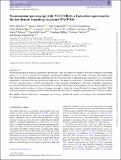Files in this item
Transmission spectroscopy with VLT FORS2 : a featureless spectrum for the low-density transiting exoplanet WASP-88b
Item metadata
| dc.contributor.author | Spyratos, Petros | |
| dc.contributor.author | Nikolov, Nikolay | |
| dc.contributor.author | Southworth, John | |
| dc.contributor.author | Constantinou, Savvas | |
| dc.contributor.author | Madhusudhan, Nikku | |
| dc.contributor.author | Carter, Aarynn L | |
| dc.contributor.author | de Mooij, Ernst J W | |
| dc.contributor.author | Fortney, Jonathan J | |
| dc.contributor.author | Gibson, Neale P | |
| dc.contributor.author | Goyal, Jayesh M | |
| dc.contributor.author | Helling, Christiane | |
| dc.contributor.author | Mayne, Nathan J | |
| dc.contributor.author | Mikal-Evans, Thomas | |
| dc.date.accessioned | 2021-08-31T16:30:01Z | |
| dc.date.available | 2021-08-31T16:30:01Z | |
| dc.date.issued | 2021-09-01 | |
| dc.identifier | 275628170 | |
| dc.identifier | 0f6067ff-0fc8-47ff-a794-a196728f84a8 | |
| dc.identifier | 85112334065 | |
| dc.identifier | 000704166800085 | |
| dc.identifier.citation | Spyratos , P , Nikolov , N , Southworth , J , Constantinou , S , Madhusudhan , N , Carter , A L , de Mooij , E J W , Fortney , J J , Gibson , N P , Goyal , J M , Helling , C , Mayne , N J & Mikal-Evans , T 2021 , ' Transmission spectroscopy with VLT FORS2 : a featureless spectrum for the low-density transiting exoplanet WASP-88b ' , Monthly Notices of the Royal Astronomical Society , vol. 506 , no. 2 , pp. 2853-2870 . https://doi.org/10.1093/mnras/stab1847 | en |
| dc.identifier.issn | 0035-8711 | |
| dc.identifier.other | Bibtex: 10.1093/mnras/stab1847 | |
| dc.identifier.uri | https://hdl.handle.net/10023/23875 | |
| dc.description | PS was supported by a UK Science and Technology Facilities Council (STFC) studentship. CH acknowledges funding from the European Union H2020-MSCA-ITN2019 under grant agreement no. 860470 (CHAMELEON). NM acknowledges funding from the UKRI Future Leaders Scheme (MR/T040866/1), Science and Technology Facilities Council Consolidated Grant (ST/R000395/1), and Leverhulme Trust research project grant (RPG-2020-82). | en |
| dc.description.abstract | We present ground-based optical transmission spectroscopy of the low-density hot Jupiter WASP-88b covering the wavelength range of 4413−8333 Å with the FOcal Reducer Spectrograph (FORS2) on the Very Large Telescope. The FORS2 white light curves exhibit a significant time-correlated noise that we model using a Gaussian process and remove as a wavelength-independent component from the spectroscopic light curves. We analyse complementary photometric observations from the Transiting Exoplanet Survey Satellite and refine the system properties and ephemeris. We find a featureless transmission spectrum with increased absorption towards shorter wavelengths. We perform an atmospheric retrieval analysis with the aura code, finding tentative evidence for haze in the upper atmospheric layers and a lower likelihood for a dense cloud deck. While our retrieval analysis results point towards clouds and hazes, further evidence is needed to definitively reject a clear-sky scenario. | |
| dc.format.extent | 18 | |
| dc.format.extent | 13981400 | |
| dc.language.iso | eng | |
| dc.relation.ispartof | Monthly Notices of the Royal Astronomical Society | en |
| dc.subject | Methods: data analysis | en |
| dc.subject | Techniques: spectroscopic, | en |
| dc.subject | Planets and satellites: atmospheres | en |
| dc.subject | Stars: individual: WASP-88 | en |
| dc.subject | Planetary systems | en |
| dc.subject | QC Physics | en |
| dc.subject | QB Astronomy | en |
| dc.subject | 3rd-DAS | en |
| dc.subject.lcc | QC | en |
| dc.subject.lcc | QB | en |
| dc.title | Transmission spectroscopy with VLT FORS2 : a featureless spectrum for the low-density transiting exoplanet WASP-88b | en |
| dc.type | Journal article | en |
| dc.contributor.sponsor | European Commission | en |
| dc.contributor.institution | University of St Andrews. School of Physics and Astronomy | en |
| dc.contributor.institution | University of St Andrews. St Andrews Centre for Exoplanet Science | en |
| dc.identifier.doi | https://doi.org/10.1093/mnras/stab1847 | |
| dc.description.status | Peer reviewed | en |
| dc.identifier.grantnumber | 860470 | en |
This item appears in the following Collection(s)
Items in the St Andrews Research Repository are protected by copyright, with all rights reserved, unless otherwise indicated.

